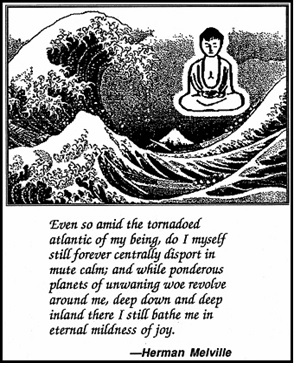In this issue:

More than thirty years ago, in that ancient time before color printers, I helped the Priory produce this New Year's card. I was quite new to training, and this quote spoke to the state of inner turmoil and agitation that I was experiencing at the time. The passage also offered the hope that it was possible to live from a deeper place even in the midst of such mental and emotional turbulence. It “grabbed” me so much that I still have the card after many moves and life changes. I committed the passage to memory then, and have found it a helpful touchstone over the years for grounding myself when I might be pulled off-center by "worries and woes." I find it a profoundly spiritual expression of living from the eternal center of our being in the midst of the difficulties of this life. Following are reflections on some aspects of the passage’s meaning for me.
"...amid the tornadoed Atlantic of my being..."— One definition of tornado is: "a person or thing characterized by violent or devastating action or emotion," and this section conjures an image of huge waves tossing and turning a small boat on a vast, storm-tossed sea, threatening to overwhelm and sink it.
There are times in everyone's life when events and situations create great stress and turmoil; times that seem "violent or devastating." The death of a loved one, a divorce or breakup of a relationship, the loss of a secure job, moving from a familiar city to one unknown.... In addition to people and experiences in our personal life that challenge our equanimity, each generation seems to have those that everyone shares in to some degree. For my generation, it was the Vietnam War and the extreme and powerful opposites of support or resistance that it inspired. It seemed then, as it has for every generation, that "things fall apart/the centre cannot hold/mere anarchy is loosed upon the world/the blood-dimmed tide is loosed, and everywhere/the ceremony of innocence is drowned."1 No one is unaffected in their "being" by the events of their time.
Such personal and generational experiences can seem to threaten us with sinking and drowning beneath the waves of turmoil and despair. Yet there's hope for survival–and even progress–on our voyage through the storms of life: "But even so...do I myself still for ever centrally disport in mute calm...". Even in times of the most extreme stress in our lives, there is a place of refuge: the "mute calm" of serene reflection meditation. The "storms" we experience are temporary and passing, but at the center of our being is a Reality of stillness, and compassion, and love, and wisdom. And this centered calm is "for ever" available to us no matter our circumstances if we but sit down, relax the strangling grip of our thoughts and emotions, and allow ourselves to sink down beneath the waves that toss us about (and it is a choice). Then, the tempestuous ocean of body and mind becomes the infinitely calm and eternally still Great Ocean Samadhi.
“…and while ponderous planets of unwaning woe revolve round me…”. The word “suffering” is often associated with the Buddhist term samsara, or this world of life and death. “Suffering” has many aspects, certainly, but its fundamental spiritual aspect is our karmically induced false sense of separation from the Eternal. This ignorance engenders a craving for external things to satisfy the deepest longing of our heart—reunion and reharmonization with the Eternal—whether we recognize that longing or not (or actively resist it). Whatever external relationships or things we crave, they cannot be the True Refuge. We ask them to fill an emptiness in ourselves that they cannot fill. Our ultimate dissatisfaction and disappointment with them, then, distorts them into “ponderous planets of unwaning woe” that whirl around in our mind and heart. Note that the problem is not in the external things themselves, but in our misperceiving them and inflating them into something they are not, whether seen as good or bad.
But this need not be our permanent state, being pulled this way and that by the gravitational pull of our revolving planets of unwaning woe. For “…deep down and deep inland there I still bathe me in eternal mildness of joy.” As the Zen tradition teaches, “The hara is the region of the body extending from the sternum to the lower abdomen. The stillness of meditation is experienced—eventually, if not necessarily at first—as centering in the hara…. This stillness is an aspect of the Buddha Nature and is not created by us, nor can it be destroyed: it is.”2 This Place is the deep and true center of our being; this Place of stillness is where meditation takes us; this Place is where we “centrally disport in mute calm;” this Place is where we “bathe in eternal mildness of joy;” this Place is where we “disport” in the Water of the Spirit.
When we live from this Place of pure meditation “the tornadoed Atlantic of our being” becomes the still waters of the Buddhaland. And just as the light of dawn renders the stars and planets invisible to our sight, the darkness that our “ponderous planets of unwaning woe” revolve in is washed out by the light of the sun of the Eternal.
__________________________
Note: the footnote references in the text links to these footnotes. To return to the text, use the Back arrow or button on your browser.
1 from "The Second Coming" by W.B.Yeats
2 Book I, Chapter 9, How to Grow a Lotus Blossom:Reflections, by Rev. Master Koshin Schomberg.
NEWS OF THE TEMPLES
North Cascades Buddhist Priory and Seattle Dharma Refuge
We would like to thank all who have made donations recently to help cover the cost of dental work and copay for surgery for priests of our two temples. We are happy to report that enough money has been raised to cover the immediate need.
